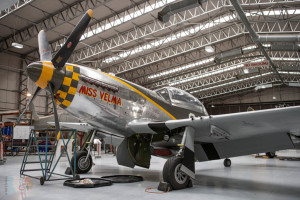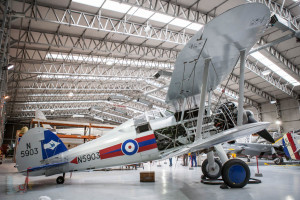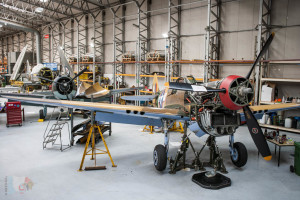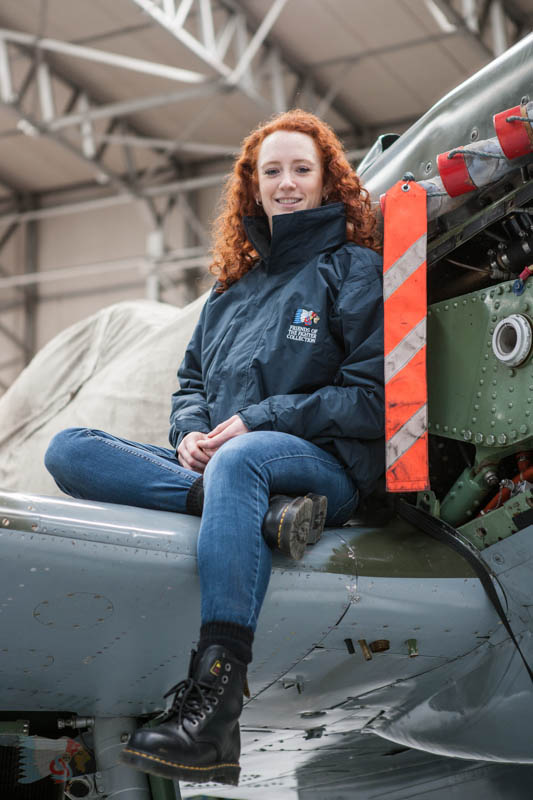
Online Edition No: 3 May 2015
Just click on the tabs below to read the various articles.
- Welcome
- Hangar Log
- Sight and Sound - Hawk P-36
- What's 69 miles between friends
- Flying Legends
- New in Store
- Competition Time
- Your Feedback
This is a special one off edition which we have made available to everyone, not just Friends of TFC with an exciting preview of the Hawk P-36 that is due to attend Flying Legends 2015.
In this edition: Hangar Log, Hawk P36 – Sight and Sounds. Nimrod challenges. Competition- (FofTFC members only), Flying Legends updates. Friends of TFC shop
A reminder we will have a stand at the May Duxford airshow, currently the plan is to be located opposite the control tower and we would love to see you all and talk about old aeroplanes! We will also have a competition to win a pair of tickets to Flying Legends 2015 – more details on the stand!
A short email instruction from ‘Webmaster’ Chris was my cue to put pen to paper and write this very late Hangar News: By the time this goes to print we will have dusted the cobwebs off the P-51D, Corsair and Bearcat with the Wildcat sat in the wings ready to go save for a pilot with strong arms!
This month sees much activity with trips to Belgium and France planned with the balance of the fleet appearing at the the May IWM show.
The current push is for the Hawk 75 and Gladiator to finish their winter inspections and be readied for ground runs over the coming weekend or early next week.
We have spent a little more time than normal on the Gladiator with a few niggles and bedding in snags to address plus some tidying up in the cockpit ridding ourselves of a multitude of non-essential placards and notices which seem to be needed in the modern age of aviation but oddly weren’t considered necessary when Gloster built her.
The only setback to our current planning was the discovery of a coolant leak from the lower skirt of A-bank cylinder on the Spitfire V after a local flight, but which has been successfully resolved by Retro Track and Air and the block will be back with us Thursday before lunch. With a little luck EP120 will be airborne again after the weekend with a couple of proving and pilot proficiency flights.
The P-40F is close to completion of its annual inspection and continuing the Curtiss theme the final design report on the P-40C is expected to be submitted to the CAA for approval in the next week.
The final part of that jigsaw is the return of the elevators from Vintage Fabrics Ltd after recovering.
Martin
.
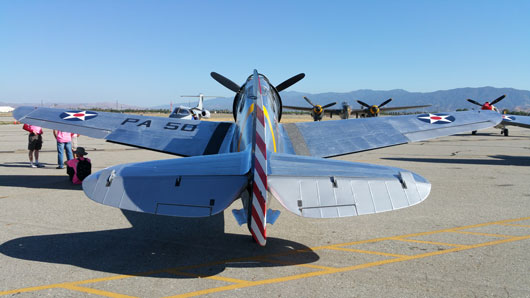
Our long term volunteer John Sanderson has just completed his annual pilgrimage to Chino (well he went last year anyway) and was keen to send us his pictures. You may recall the diary pieces he provided last year. Well he started this year (again) with great confusion by discovering that Biggin Hill was not in Kent at all but the other side of the pond – at San Diego Air and Space Museum..

Then our internet connection slowed to a complete crawl as John sent us an amazing folder with no information which was full of photos …. and then a rather noisy video – please enjoy the sight and sound of the P-36 and friends.
Steve Hinton Sr in the P36 and John Maloney in the P35. Taxing out for a photoshoot using the B25 as the camera ship.
More information about the Curtiss Hawk can be found here at FlyingLegends.com
Finally John is now the proud owner of not one but two Planes of Fame Airshow Hot-Ramp Crew pink t-shirts! A big thanks to John for taking time out from a very busy weekend to send us the video and photos.

Steve Hinton ‘selfie’ he took in front of the Hot-Ramp crew who worked the airshow (“I am in there somewhere”, says John).
Back again next year?
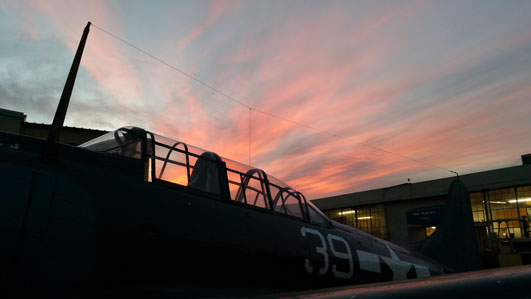
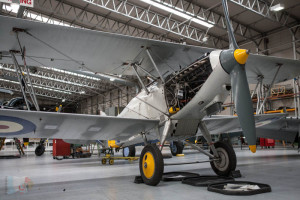
For all the aeroplane is a beautiful piece of thirties inspired engineering (many in the hanger think I’m alone on that point) it has relatively simple systems; the cooling system for instance is an open vented affair which is why it ‘steams’ occasionally on landing. We noticed at the back end of last year the radiator had developed a minor core /case leak leaving us little reminders (puddles) on the hangar floor as though it were marking it’s territory. Over the winter lay-up the engineers removed the radiator and consigned it to our specialist contractor Anglia Radiators Ltd for investigation and repair. The repair itself was simple enough, clean off existing soldered joint, tin, and resolder; a pressure test and soak in a water tank proved the repair had been effected satisfactorily and in no time flat the radiator assembly was back in the aeroplane.
The header tank on the Nimrod is at the rear of the engine mounted on the firewall, this means that with the aeroplane in a tail down attitude air can be trapped in the engine cooling rails that run to the front of the cylinder banks so to purge the system we fill with the tail up ensuring any air in the engine cooling jacket is pushed out back to the header tank. Once filled an engine run to check the soundness of all the joints we have disturbed is all that required to return the aircraft to serviceability (at least that is what we thought at the time).
January is cold at the best of times and running an open cockpit aeroplane was guaranteed to be an icy affair, so after donning a jacket [as available TFC Shop – click HERE – Ed] (and doing a few warm up exercises) the engine was primed; four shots and two blades, radiator shutters ‘closed’, throttle set 1/2″ open, switches ‘on’, starter mag ‘on’ – CONTACT. Two enthusiastic engineers who had previously been limbering up, turn the starting handles furiously and the Rolls Royce Kestrel bursts in to life. Starting handles removed, the engine is allowed to warm up at 1200rpm until at 60 degrees coolant temperature the radiator shutters are opened to half way. Oil temperature is still quite cool at 25-30 degrees but with no shutters system to help it that is what it is. A quick check of the mags; LH switch ‘off’ 30 rpm drop, RH switch ‘off’ engine cough and splutters….okay let try that again but at higher RPM to burn off any fouling on the plugs; Two engineers on the tail for ballast, and set 1600RPM, LH mag switch ‘off’ 50rpm drop, RH mag switch ‘off’ engine coughs, coughs again and stutters 100-150rpm drop but not consistent.
After allowing the engine to cool the plugs are removed, individually inspected, cleaned and pressure tested; the second ground run shows the same fault on the LH magneto. An HT test with a megger showed no obvious harness fault, so it looks like we have magneto problem
The Rolls Royce Kestrel can be fitted with two similar but none the less different magnetos; A BTH model SC-12 and a Watford SP-12. In our case the engine is equipped with a Watford magneto firing the exhaust plugs on B-bank (LH) and a BTH magneto firing the inlet plugs on the A-Bank (RH). The Watford magneto was originally produced by North and Sons Ltd who were one of the leading manufacturers of magnetos and speedometers for motor vehicles prior to their acquisition by Lucas in 1933 and who coincidentally were based in Watford, Hertfordshire. Lucas produced lighting and starting equipment, magneto and radio equipment under the Watford-Rotax branded aviation equipment from 1937 having previously acquired the assets of Rotax Motor Accessories in 1926. The BTH magneto owes it origins to the British Thomson-Houston Company of Rugby who were established in the UK in 1899 and known primarily for their electrical systems and steam turbines.
History lesson over, the suspect magneto was removed and delivered to our specialist engine contractor Vintage Engine Technology (known locally as Vintech) for investigation. A bench test indicated a miss-firing magneto. The cause of which on disassembly and further inspection revealed itself to be a failed condenser. As you might image replacement condensers for a seventy year old magneto aren’t exactly an ‘off the shelf item’ but fortunately the engineers at Vintech had in their stores a serviceable replacement enabling them to restore the Watford magneto to a fully operational state. The cause of the condensor failure was somewhat of a mystery, particularly since we had not experienced any such issues with the engine during last season, with that in mind we elected to remove the A-Bank BTH Magneto as a precaution and check the operation by carrying out an endurance test on the bench. With both magnetos bench tested and fully servicable the task of timing them to the engine could begin; the Kestrel V can be timed using one of two timing positions A6MA (Translates to A-Bank cylinder number 6, Magneto Advanced) or B1MA (B-Bank cylinder number 1). On the supercharged engines both magnetos are timed to the same point at 37degrees Before Top Dead Centre. With the magneto’s fitted and timed the distributors and individual ignition cables can be refitted. Unlike the later Merlin engine with its modular construction ignition harnesses the Kestrel has individual single cable high tension leads inserted radially into the distributor block sheathed with a metal braid.
The weather has improved slightly at the point we are ready to test run the engine; so with the engine hot oil primed attempt three resulted in nothing more than an odd cough when the engine was turned over. Starts four and five yielded much the same result save for the fact we had exhausted the engineers turning the starting handles. With two serviceable magnetos it smacked of a timing issue so back to the hangar to check it out, but no, both magnetos were spot on B1MA. A bit more investigation pointed to the fact the hand starting magneto which feeds the distributors on both engine magnetos had no HT output. A further visit to Vintech confirmed our suspicions when verdigris was discovered on the armature slip ring effectively insulating the two rotating contacts such that the magneto had no output. After a thorough refurbishment by the engineers at Vintech the hand starting magneto was refitted and we were ready for engine run number six.
With the engine primed and throttle set, the Kestrel started first go but it became clear almost straight away our rough running hadn’t entirely disappeared, as a slight vibration could be felt through the airframe and with the right magneto switched off the instruments were a bit of a blur !
Convinced the initial problem with condenser failure had reappeared the left hand ‘Watford’ magneto was once again removed for bench test. The bench test was satisfactory in as much as all 12 spark gaps were operating, but further investigation showed the distributor rotor arm was not in the correct alignment with the distributor contact when the contact breaker points were just opening; Vintech re-investigated the issue and after dismantling the magneto and setting up in accordance with the overhaul manual we concluded that the camshaft on the full speed gear had in fact been at sometime in the past been incorrectly indexed which meant it had to be ‘compensated’ by changing the magneto internal timing hence the discrepancy on the rotor arm alignment.
Of course all of this investigation, work and re-work is coincidental to the fact the Nimrod was due to appear at the Shuttleworth Collection’s May airshow show in the company of two more Hawker stablemates…. We were finally able to refit the Watford magneto on the Friday evening before the Sunday show, leaving enough time on Saturday to finish re-installing the distributor and ignition leads. By four o’clock on Saturday afternoon we finally had a happy Kestrel engine and three very happy engineers (albeit two with tired arms, but much improved upper body definition!). The weather on Sunday precluded the Nimrod making an appearance on the ground at Shuttleworth but a very successful flight of 1:05hrs was concluded when Brain Smith was able to fly into slot at the allotted time at Old Warden in the company of a Hawker Demon and Hawker Hind.
So, what’s 69 miles between friends …? Well the clues are in the narrative, Watford – Rugby (69 miles as the crow flies!) Friends, those people who lend a hand when you need it most, like in this instance our specialist contractors Anglia Radiators and Vintage Engine Technology…..
Sale Time
grab a Bargain
Waterproof Jackets
£45.00
Just in stock. Same style as worn by TFC engineers
Zip front with velcro stormflap.
Two zipped jet pockets.
Concealed hood with adjuster.
Side elasticated waistband.
Tab adjustable cuffs.
Zip embroidery access.
Internal mobile phone pocket and zipped patch pocket.
Size Chest (to fit) M – 40/42″ L – 44/46″ XL – 48/50″ 2XL – 52/54″.
Fabric Nylon Taslan with waterproof coating.
100% Polyester microfleece lining.
Click HERE to buy
Do you like the layout of our new Fighter Log? Let us know, just click HERE

